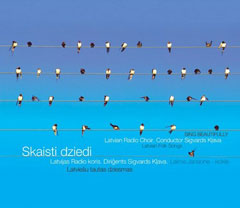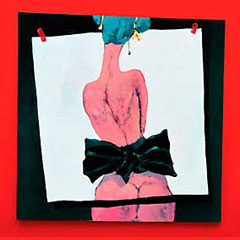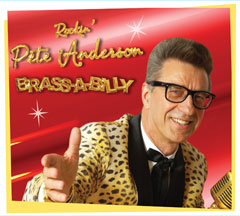
It goes without saying that Latvians have many beloved folk songs. It also goes without saying that Latvians love singing, especially folk songs. Also well known is the fact that the Latvian Radio Choir, conducted by Sigvards Kļava, is one of the best choirs in Latvia, if not the world. It is appropriate, then, that just in time for the 2008 Latvian Song Festival the record label Upe tuviem un tāliem would release a collection of folk songs, Skaisti dziedi.
When I heard about the compact disc, I picked it up as soon as I could. What surprised me is that only half of the songs are full choir performances. The rest are solo performances.
The choir arrangements are all the “classic” arrangements such as “Pūt, vējiņi” and “Kur tu skriesi vanadziņi” by Andrejs Jurjāns, “Rīga dimd” and “Krauklīt’s sēž ozolā” by Jānis Cimze, and “Cekulaine zīle dzied” and “Tumša nakte, zaļa zāle” by Emilis Melngailis. Though these songs have been recorded many, many times, the presentation by the Latvian Radio Choir and conductor Kļava remains fresh and engaging.
The other half of the disc contains performances by solo artists such as folk singer Zane Šmite (“Vedat mani ciema puiši”) and Kārlis Rūtentāls (“Kur tu teci gailīti mans” and “Skaisti dziedi lakstīgala”), as well as the duo of countertenor Ārijs Šķepasts and bass Gundars Dziļums on the old favorite “Kur tad tu nu biji, āzīti manu.” Most all of these performances feature kokle prodigy Laima Jansone (in fact, she arranged every song she plays on—more than a dozen). Still not quite yet finished at the Latvian Academy of Music, she already is able to make quite a name for herself as a rising star of the kokle, one of the most Latvian of all instruments.
The only spots where the collection stumbles are the performances of “Āvu, āvu baltas kājas” and “Bēdu manu lielu bēdu” by soprano Elīna Libauere. The songs, in my opinion, are sung way too fast! It is for the same reason that I wasn’t too fond of the Liku bēdu zem akmeņa folk song collection released by Upe in 2007. Certainly it is a technical achievement to be able to sing a song at 90 miles per hour with barely a breath, but at that speed much of the joy and fun of these songs is diminished.
All song texts are included, including English translations that perhaps may lead to bewilderment among some who may not understand why a tune about an “alleged” drunk horse runner became such a beloved song.
Honestly, instead of the half CD of choir arrangements and half CD of solo performances, I would have preferred a full CD of each. Conspicuously absent are the Latgallian “Aiz azara augsti kolni” (also by Jurjāns) or any of the many arrangements of “Ziedi, ziedi, rudzu vārpa.” Of course, with literally hundreds of choir arrangements of folk songs, one has to be very selective. Perhaps in the future we could hope for another CD of all modern folk song arrangements, including favorites such as Anita Kuprisa’s arrangmenet of “Ģērbies, saule, sudrabota,” or Imants Ramiņš’ arrangement of “Pūt, vējiņi,” or Selga Mence’s arrangement of “Neba maize pate nāca,” to name just a few.
As a collection of Latvian folk songs, containing old favorites and new arrangements for solo performers, this is one of the best to have ever been released, and well worth picking up. The Latvian Radio Choir and Kļava, not to mention kokle performer Jansone, are to be commended for such great performances, which will remind all listeners of the value and beauty of these timeless songs.
Details
Skaisti dziedi
Latvian Radio Choir
Upe tuviem un tāliem, 2008
UPE TT 038





